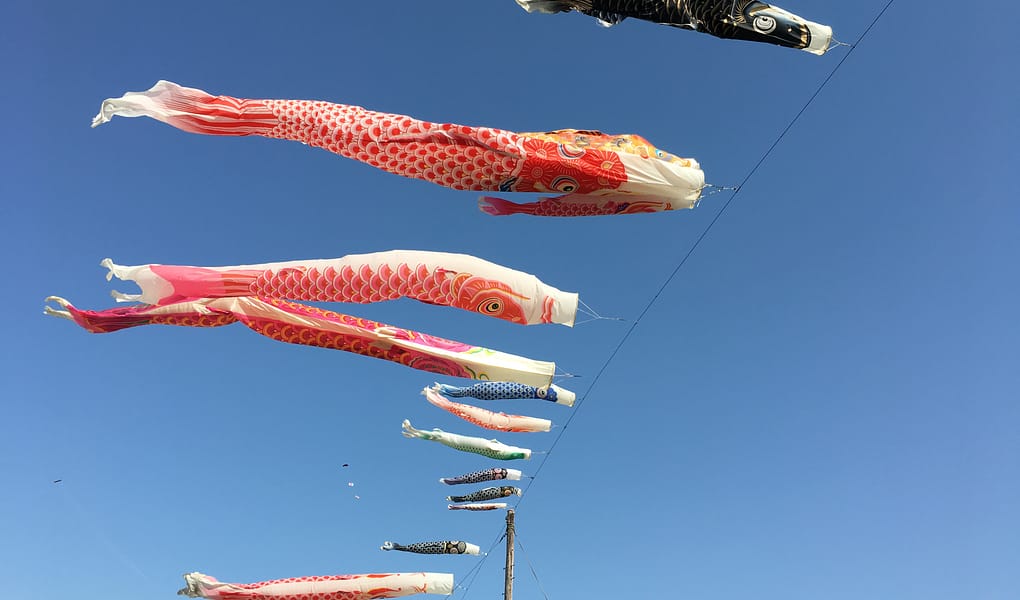Kites rise highest against the wind – not with it. – Winston Churchill

It’s a warm, clear day and the sun is shining. After a few days of rain the week before, I’m grateful for the warmer temperatures. The weather in this area is not what I was expecting. The mid-60-degree temperatures advertised for our arrival are cooler than expected. It feels more like fall. And each afternoon the winds pick up, blowing 15-20 miles per hour and making lots of noise in the process. A day out enjoying the weather and a relatively calm breeze is just what we need. We heard a festival was going on, so we set out to see what it’s all about.
Two weekends ago, Husband and I and a few friends attended the Giant Kite Festival of Sagami. This festival comes at the end of Golden Week, a yearly celebration of four national holidays in seven days. Because of the cluster of holidays, many Japanese people and companies close for the week, allowing people to travel. Traffic increases and shops keep inconvenient hours (if any at all). But it is a good time for sales at some of the major retailers. (If you’re interested in learning more about Golden Week, check out Japan Guide and Japan.org for Kids).
The Giant Kite Festival has been going on since about 1830 and I sense not much has changed since then. Our group arrived walking, still not ready to wrestle Japanese roads and traffic (not to mention none of us had a car). On our way to the banks of the Sagami River, we saw lots of rice paddies and small farms. A few unattended kites pointed us in the right direction.
The event had already started when we arrived, and there were a fair amount of people in attendance. Once oriented, we find booths selling snacks and small trinkets. Vendor stalls line up to form a makeshift “road,” and we start here to get something to eat. We decide on deep-fried cheese, some yakitori (skewered chicken grilled over charcoal), and a pancake type dish with lettuce and sauce and vegetables. The cheese is very tasty, but we got a surprise with one of the yakitori skewers. Salted chicken gristle with onion, I learned, is not my favorite. Overall, and as expected, the street food did not disappoint. I haven’t yet mastered the art of eating from a plastic to-go container with chopsticks while standing up and/or walking, so I wait for a thinner crowd (and space to sit on the sidewalk) to enjoy mine.


After we line our stomachs, we follow the crowd and find a higher spot in the shade to stand. I was expecting individuals to be flying kites simultaneously, but instead, the event seemed to be focused on just a few. Carp shaped kites hang along an electrical wire, marking the celebration of Children’s Day (the last of the Golden Week festivals).
The Giant Kites, called Sagami-no-Oodako, are the large kites flown for the festival – some of the largest in the world. The biggest of the kites measures 14.5 square meters (about 47.5 feet) and weighs about 950kg (about 2,094 pounds). It takes between 80 and 100 people to get this huge kite off the ground and in the air.
Traditionally, kites are constructed of bamboo and 16 large pieces of Japanese paper. Written on the paper, in red and green, are two Chinese characters. The characters, called “the title,” embody the spirit of the local community and its hopes, dreams, and pride. Each year the local community votes on the title that will be displayed on that year’s flag.

Despite a very windy day the day before, the weekend had calmed some. There were some smaller square kites that got some air time, but the large kite we were watching never got airborne. The second kite “field” (another area set up identically to where we were), was home to a large kite that got a few seconds of air.




Our group hung around for a while, hoping that the kites would fly. We wandered through the vendors, drank some local beer (brewed with sunflower seeds) and bought festival buttons. At the end of the field, we found some large drums and other instruments that had been used while the kite was getting ready for take-off. I’m not quite sure the significance of the drums, but I was able to grab some pictures of the drummers as they were posing for pictures of their own.
We had a great time at this event and hope to attend again next year. It’s a two-day ordeal so we’d like to see how things are on Friday instead of Saturday. I love the Japanese spirit of celebration. Every day brings something to celebrate.
Want to learn more about the Giant Kites of Sagami? Check out Must-See Japan and the Giant Kites of Sagami.


LYMI